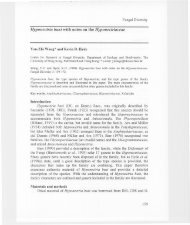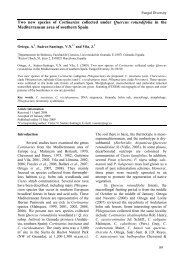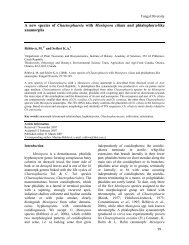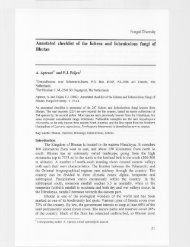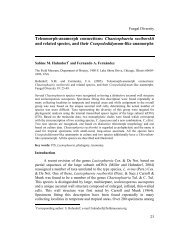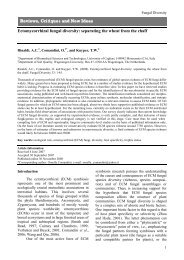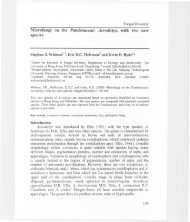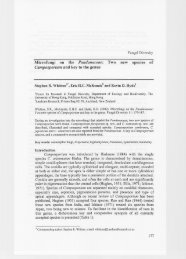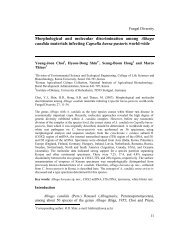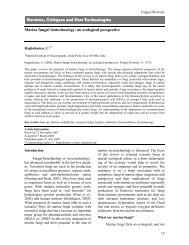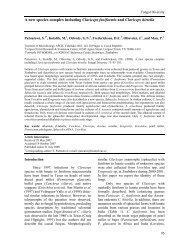A nomenclatural revision of the genus Alnicola - Fungal diversity
A nomenclatural revision of the genus Alnicola - Fungal diversity
A nomenclatural revision of the genus Alnicola - Fungal diversity
Create successful ePaper yourself
Turn your PDF publications into a flip-book with our unique Google optimized e-Paper software.
Table 1. Interpretations <strong>of</strong> Naucoria in literature.<br />
<strong>Fungal</strong> Diversity<br />
Authors Modern genera included in Naucoria Name used<br />
for <strong>Alnicola</strong><br />
Fries (1874) Agrocybe pp., <strong>Alnicola</strong>, Flammulaster, Galerina pp., Naucoria<br />
Konrad (1934) Macrocystidia, Phaeocollybia, Phaeomarasmius,<br />
Lange (1938)<br />
Pilát (1951)<br />
Phaeonematoloma, Simocybe<br />
Heim (1931) <strong>Alnicola</strong>, Flammulaster, Phaeomarasmius, Simocybe Naucoria<br />
Kühner and<br />
Romagnesi (1953,<br />
1957)<br />
Locquin (1956)<br />
Malençon and<br />
Bertault (1970)<br />
Singer (1936, 1946,<br />
1949, 1950a, etc.)<br />
Horak (1968)<br />
Romagnesi (1942)<br />
Favre (1948)<br />
<strong>Alnicola</strong>, Flammulaster, Phaeomarasmius, Simocybe,<br />
Tubaria<br />
<strong>Alnicola</strong>, Descolea, Flammulaster, Phaeomarasmius,<br />
Simocybe, Tubaria<br />
Naucoria<br />
Naucoria<br />
Simocybe <strong>Alnicola</strong><br />
Flammulaster, Phaeomarasmius, Simocybe <strong>Alnicola</strong><br />
Romagnesi (1950) Flammulaster, Phaeomarasmius <strong>Alnicola</strong><br />
Orton (1960) <strong>Alnicola</strong>, Galerina pp., Phaeogalera, Simocybe Naucoria<br />
Romagnesi (1977) Flammulaster pp., Tubaria <strong>Alnicola</strong><br />
Kühner (1980) Flammulaster, Phaeogalera, Phaeomarasmius, Tubaria Hebeloma<br />
Pegler and Young<br />
(1968)<br />
Reid (1984)<br />
Moser (1955)<br />
Døssing (1992)<br />
<strong>Alnicola</strong> Naucoria<br />
Singer (1962, 1975,<br />
1986)<br />
Kühner (1987)<br />
Rejected <strong>Alnicola</strong><br />
author, seems somewhat different from continental collections usually reported<br />
as A. escharoides (it gets closer to A. diplocystis Sing.); it is not a<br />
significatively veiled collection.<br />
Moser’s interpretation is certainly <strong>the</strong> interpretation which comes closest<br />
to <strong>the</strong> one put forward by Fries (1828) redefinition <strong>of</strong> Ag. escharoides; but<br />
originally (1821), Ag. escharoides is a veiled taxon probably based mainly on<br />
A. luteol<strong>of</strong>ibrillosa (as Moser (1985-2003) and before him Kühner (1942)<br />
pointed out), and probably partly on collections <strong>of</strong> Tubaria (Singer, 1986). In<br />
order to select a lectotype, only <strong>the</strong> Systema Mycologicum (Fries, 1821) should<br />
be considered as an original document, and Ag. escharoides should <strong>the</strong>n be<br />
127



